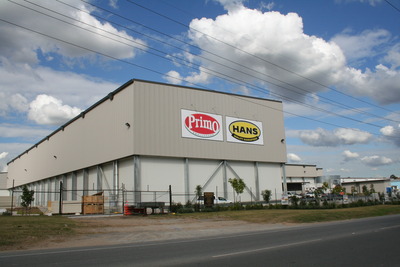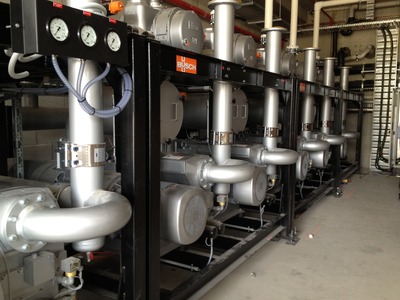Centralised vacuum supply is reliable and efficient
Based in Brisbane, Primo Smallgoods is one of Australia’s largest smallgoods producers. The company’s processing facility relies on a centralised vacuum unit from Busch Australia for its vacuum supply. The unit is an important part of production and guarantees that the meat products are hygienically, quickly and reliably packaged.
Primo’s main criteria for using central vacuum supply were hygiene and the dispersal of waste heat created by the vacuum pumps in the packaging room, as well as easier and less frequent maintenance.

In order to run each packaging line with minimal energy expenditure while keeping the number of cycles as high as possible, the packaging rooms are evacuated in two stages. The critical drop in pressure is used and therefore a quick evacuation is made possible.
The first stage of evacuation is done by a low vacuum pump stand; the second, with a medium vacuum pump stand. The changeover valves with the corresponding rerouting electronics are directly attached to the individual packaging machines, controlling the transition from a low to medium vacuum.
A third vacuum pump stand provides vacuum for the forming stations in the packaging machines. Here, the base film of the packaging is heated and thermoformed with a vacuum and compressed air. This vacuum pump stand operates independently of the other two.
This separation of different vacuum stations is necessary for the supply to the packaging machines as these have a thermoforming and sealing function that need to run with vacuums of varying degrees. The pipe work serves as a vacuum buffer with more than 850 m of piping in the roof. This buffer is necessary to keep the packaging pressure at a constant level, even when all packaging machines are running with the same number of cycles.
The central vacuum unit is fully automated and runs as required, meaning that it switches on when a vacuum is required and switches off when the packaging machines are not in use. If a problem occurs in a vacuum pump when it is in low, medium or thermoforming mode, then a reserve pump is automatically activated. This maximises the reliability of vacuum supply to the packaging machines while ensuring it is energy efficient.
The centralised vacuum unit is integrated with the control technology, which controls and monitors the entire utility supply, ensuring permanent access to the operating data of each vacuum pump in the unit. This data is automatically archived and can be analysed over extended periods of time.

The system capacity of the rough vacuum at 15,000 m3/h at 50 mbar and fine vacuum at 12,500 m3/h at 5 mbar provides very fast evacuation time, reducing cycle time while increasing production rates. The capacity of the system while on standby is 3000 m3/h. The Busch central vacuum system ensures economic efficiency by offering approximately 140 kW of power reduction.
Primo’s packaging lines are classified as ‘high-risk’ hygiene areas. Products are cut and portioned immediately before being packaged, so the surface of the product is at its greatest and therefore poses the highest risk of contamination. Having the centralised vacuum supply outside the production and packaging rooms minimises the risk of contamination, as this precludes the meats being contaminated by emissions from the vacuum pumps. In addition, maintenance personnel do not need to access these areas as no maintenance is required in the production and packaging rooms.
Keeping the vacuum pumps in a cooled room prevents heat being wasted. This has several benefits. Firstly, air conditioning in the packaging room is used less, saving energy and cost. Secondly, by centralising the vacuum pumps, 33 kW of heat load can be removed from the packaging room, saving money on refrigeration costs.
The central vacuum unit was constructed modularly by Busch, making it possible to adapt the unit to differing production conditions. Initially, the unit was configured conservatively, but increasing demand even as early as the production start-up phase meant the central unit was expanded by several modules to deal with increased production and to cope with output peaks.
Reduced maintenance costs ensure cost-effectiveness, as there are fewer vacuum pumps installed; the reduction of installed vacuum pumps decreased from approximately 85 units to 24. To further minimise the risk of high costs and outage of the running plant, Busch has taken on maintenance of the system. This involves controlling the maintenance intervals and the work and services that need to be done while providing a basis for an extended warranty for the vacuum unit. In practice, maintenance work is carried out by Busch customer services twice a year.
Maintenance takes place while the unit is running, without having any adverse effects on production. This is another advantage of a modularly constructed central unit, as the modules in the vacuum system control can be individually disengaged. A reserve pump stand is automatically activated if a module is switched off. Busch customer services record the data from the vacuum pumps, maintenance work and the results of vacuum level and energy usage. Primo is therefore informed of the current condition of and possible necessary changes to the vacuum unit
Six beverage trends predicted for 2026
Demand for customisation, 'protein-ification' and sustainable storytelling are some of...
Making UHT processing less intensive on energy
A nutritional beverages company was seeking a more sustainable way to produce UHT beverages using...
Tasty twist for chocolate alternatives
Food scientists develop two novel flavour-boosting techniques to transform carob pulp into a...











